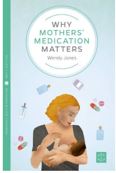I’ve realised that the information I wrote long ago now, on loss of a pregnancy and breastfeeding is not very detailed so I have written a more detailed factsheet. My heart goes out to everyone who has to go through the loss of a baby through miscarriage. We don’t talk about it openly often enough considering how common it is .
If the baby is lost whilst you are still breastfeeding an older child your milk supply may suddenly increase. If your child isn’t feeding as frequently you may risk mastitis so please be aware if you suffer engorgement and your nursling doesn’t remove the full supply.
If the miscarriage is late in pregnancy then milk production may still begin and this may come as a shock see https://breastfeeding-and-medication.co.uk/fact-sheet/stillbirth-and-milk-supply
Sending hopeful rainbows for the future

miscarriage and breastfeeding factsheet
Sometimes longed-for pregnancies end in miscarriage. The signs of miscarriage may be vaginal bleeding and cramps in the lower abdomen. You may need to take painkillers as you would for period pains. Sometimes not all the ‘products of conception’ may be expelled. You may be monitored by the early pregnancy unit who will scan your uterus and advise accordingly. You may be treated elsewhere in the hospital.
However, you may find yourself in the heart-breaking situation of attending for a scan to be told that your baby has no heartbeat and died some time ago. You may not have had any symptoms that a problem has occurred but with hindsight may recognise that symptoms of morning sickness had eased. This is called a missed or silent miscarriage.
You may be given drugs to bring on the miscarriage (medical management) or you may be offered an operation to make sure the womb is clear (surgical management), You may prefer to wait for nature to take its course and your body to expel the baby in its own time – this happens in around 50% of cases. The decision is yours after a fully informed discussion with those caring for you and your family.
Medical management
You can continue to feed as normal after misoprostol and after mifepristone https://www.sps.nhs.uk/articles/medically-terminating-a-pregnancy-during-breastfeeding/
Some units use mifepristone tablets to break down the lining of the uterus and you can feed as normal after taking that drug. Normally you return for the second tablets after 48 hours, but this alone may bring on the miscarriage in some women.
You may alternatively be given a single dose of misoprostol vaginally. Or you may be offered a two-stage medication procedure: a mifepristone 200mg tablet orally followed 24–48 hours later by misoprostol 800 micrograms. This is usually given as a pessary but can be a tablet under the tongue (sub lingually). You may also be given painkillers, anti-sickness tablets and antibiotics. You can continue to breastfeed an older baby 4 hours after the misoprostol to avoid risks of diarrhoea in your nursling although Hale suggests that this may be unnecessary. The misoprostol helps the neck of the womb (cervix) to open and lets the remaining pregnancy come away.
Pain and bleeding usually occur within one to two hours of using misoprostol. Often bleeding is heavy with clots. It is not unusual to soak four to six pads in the first hour. You may see the pregnancy sac when it passes, but you will probably not see a recognisable baby if it is still very early in the pregnancy. Most women experience strong cramps and abdominal pains. These pains are usually strongest while the bleeding is heavy and should ease off quite quickly once the pregnancy remains have passed. You can use pain relief medication such as ibuprofen, paracetamol and dihydrocodeine.
If bleeding does not start within 24 hours you need to contact the unit looking after you.
Surgical management
As soon as you are awake and alert following surgery you can continue to breastfeed your nursling as normal
You may be offered, or ask for, surgical removal of the miscarriage although this is much less common due to the effectiveness of the medication and that you can take that at home.. Surgery will involve a general or local anaesthetic and you can feed as normal as soon as you are awake and alert. This procedure can be called a D and C or an ERPC when performed under GA but an MVA when under a local anaesthetic The pregnancy is removed through the cervix. You may be given tablets to swallow or vaginal pessaries before the operation to soften your cervix. These do not affect breastfeeding. Surgery will usually take place within a few days of your miscarriage, but you may be advised to have surgery immediately if you are bleeding heavily and continuously or there
are signs of infection. It may also be offered if medical treatment to remove the pregnancy has been unsuccessful.
Following the miscarriage
It is important to give yourself time to grieve – this was the loss of a dream as well as a baby. It is common to feel guilty as well as sad. Many families don’t share the news of a pregnancy until after the 12-week scan ‘just in case’, but if something happens you need friends to care for you, so consider letting them know what’s happened.
The reasons for miscarriage are many and varied. in women under 30, 1 in 10 pregnancies will end in miscarriage. It is common but something we rarely talk about openly. Just because it has happened once does not increase the chances of it happening again but quite naturally you will worry. Most people are advised to wait a full cycle before trying to conceive again to give mind and body time to heal. It also makes dating of the next pregnancy easier if conception does occur rapidly.
See https://www.nhs.uk/conditions/miscarriage/causes/ for more information.
Prevention of recurrent miscarriage
Some women experience recurrent miscarriages and need to take medication in order to protect the foetus. This may include the use of 75 -150mg aspirin, progesterone pessaries and low molecular weight heparin injections. All of these are compatible with normal breastfeeding. About 1 in 100 women experience recurrent miscarriages (3 or more in a row) and many of these women go on to have a successful pregnancy
What happens to the remains of the pregnancy?
Many people pass the pregnancy sac whilst on the toilet. Some people choose to just flush the toilet or do so automatically. Some want to look more closely first. Others choose to bury it in the garden maybe near a shrub or flowers. All these reactions are normal and individual. There is no right or wrong. Do what feels the right thing for you. You will not ever forget this day, this baby or this little one’s due date. Hopefully in the future you will have your Rainbow baby (a baby born subsequent to a miscarriage, stillbirth, or the death of an infant from natural causes).
References and Resources
- Breastfeeding and Medication. Jones W Routledge 2017
- BPAS Medical management of miscarriage. Accessible from: https://www.bpas.org/more-services-information/miscarriage-care/medical-management/
- Guys and St Thomas Medical Management of Miscarriage. Accessible from: https://www.guysandstthomas.nhs.uk/resources/patient-information/gynaecology/medical-management-of-miscarriage.pdf
- Hale TW Medications and Mothers milk (online access)
- LactMed https://www.ncbi.nlm.nih.gov/books/NBK501922/
- NHS Miscarriage: Accessible from: https://www.nhs.uk/conditions/miscarriage/
- NICE NG 126 Ectopic pregnancy and miscarriage: diagnosis and initial management. Accessible from https://www.nice.org.uk/guidance/ng126
- Royal College of Obstetrics and Gynaecology Early Miscarriage patient information leaflet. Accessible from: https://www.rcog.org.uk/globalassets/documents/patients/patient-information-leaflets/pregnancy/pi-early-miscarriage.pdf
- The Miscarriage Association https://www.miscarriageassociation.org.uk/
- The Miscarriage Association Management of Miscarriage. Accessible from: https://www.miscarriageassociation.org.uk/wp-content/uploads/2016/10/Management-of-Miscarriage-April-2019.pdf
- “Why Mothers Medication Matters” Jones W Pinter and Martin 2017
This information is dedicated to the two grandchildren I never got to meet

